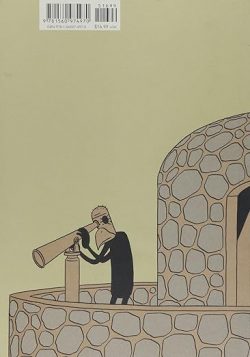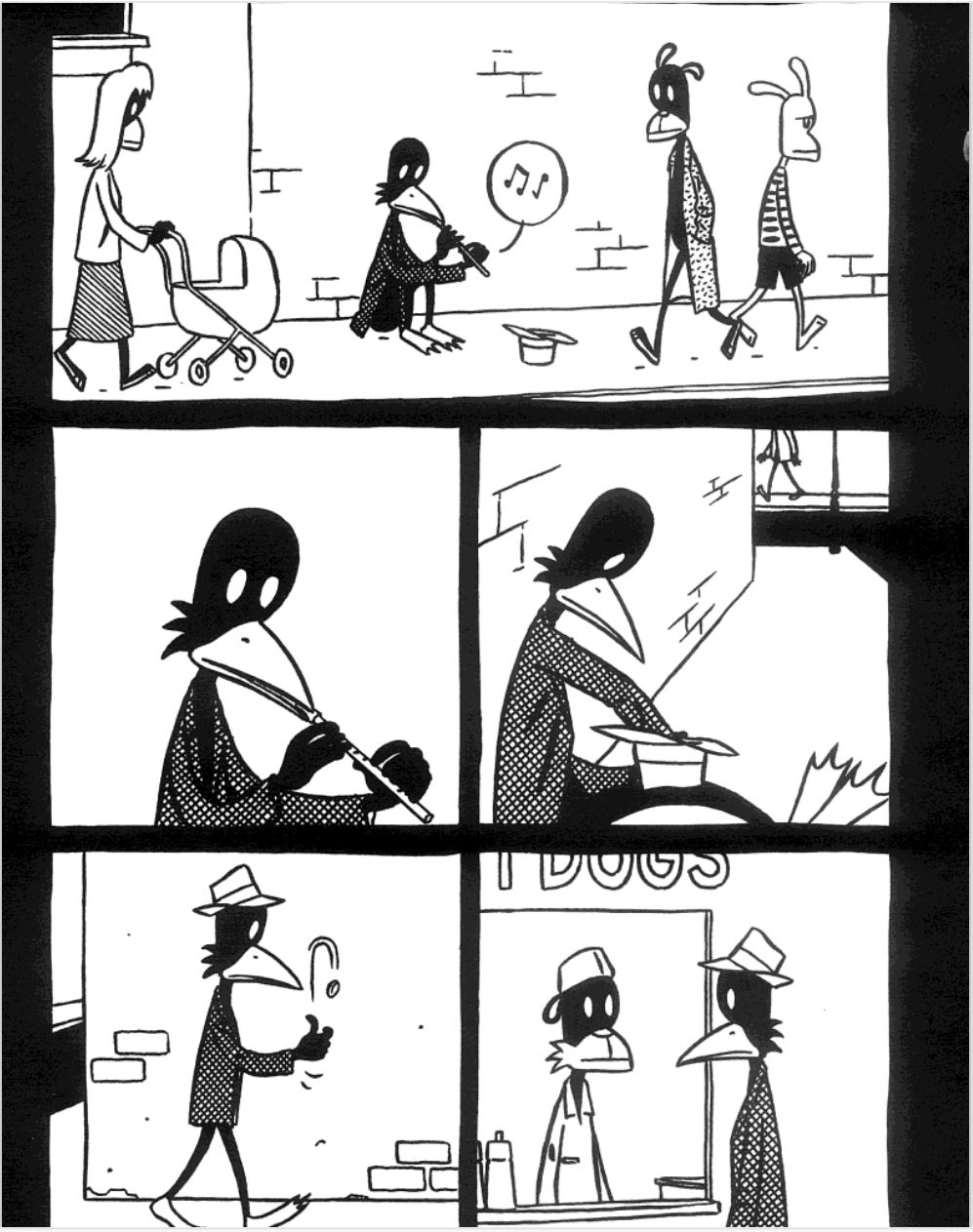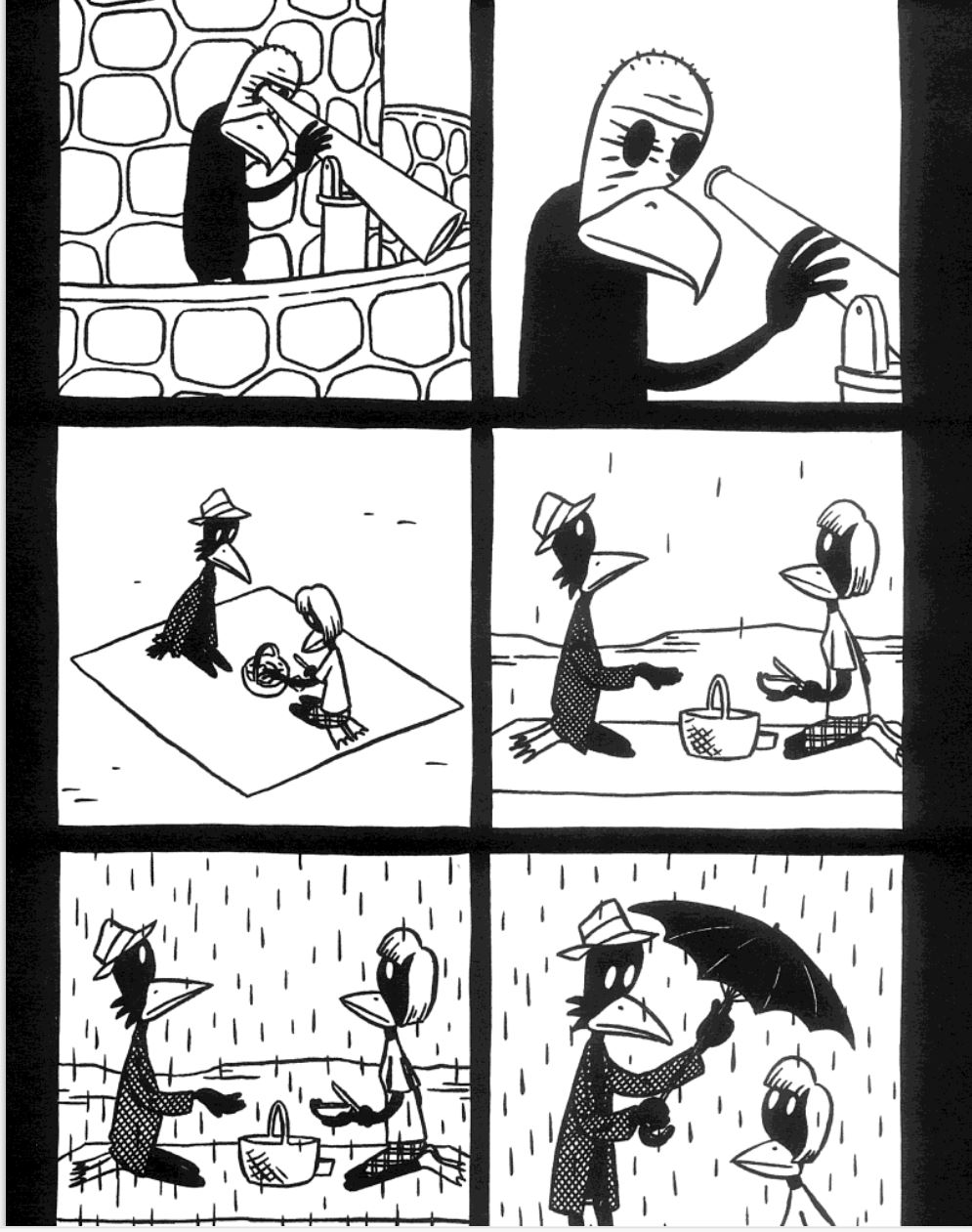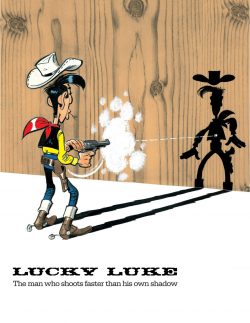
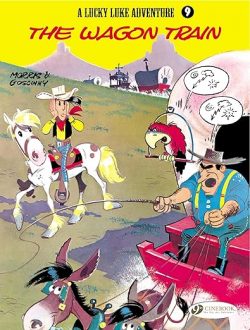
By Morris& Goscinny translated by Luke Spear (Cinebook)
ISBN: 978-1-90546-040-3 (Album PB/Digital edition)
This book includes Discriminatory Content produced in less enlightened times.
One could quite convincingly argue that the USA’s greatest cultural export has been the Western. Everybody everywhere thinks they know what Cowboys and Indians are and do, but the genre has long migrated and informed every aspect or art and literature all over the planet. Comics particularly have benefited from the form, with Europe continuing to produce magnificent works even in these latter years when sagebrush sagas are barely visible in American entertainment and instead play out on the streets and in the courts…
This side of the pond, cowboys were a key component in all nooks & crannies of popular fiction from the earliest days. Newspapers were packed with astoundingly high-quality strips ranging from straight dramas such as Gun Law and Matt Marriott to uniquely British takes like Bud Neill’s outrageous spoof Lobey Dosser, whilst weekly kids comics anthologically abounded with episodic exploits of Texas Jack, Desperate Dan, Colorado Kid, Davy Crockett, Kid Dynamite, Buffalo Jack and more.
As previously mentioned, Europe especially embraced the medium and expanded the boundaries of the genre. In Italy Tex (Willer) remains as vital as ever, far outdistancing later revered and much-exported series such as Captain Miki, Il Grande Blek, Zagor, Larry Yuma, Ken Parker, Magico Vento and Djustine. The Franco-Belgian wing also has a long tradition of variety with true immortals amongst its ponderosa Pantheon: from all ages-comedic treats such as Yakari, OumPah-Pah, Chick Bill or The Bluecoats to monolithic and monumental mature-reader sagas like Jerry Spring, Comanche, Sergeant Kirk, La Grande Saga Indienne, Buddy Longway or the legendary Blueberry…
Topping them all in terms of sales and fame, however, is a certain laconic lone rider…
A precocious, westerns-addicted, art-mad kid, well off and educated by Jesuits, Maurice de Bevere was born on December 1st 1923 in Kortrijk, Belgium. A far from illustrious or noteworthy scholar – except in all the ways teachers despise – Maurice later sought artistic expression in his early working life via forays into film animation before settling into his true vocation. While working at the CBA (Compagnie Belge d’Actualitiés) animation studio, “Morris” met future comics superstars Franquin & Peyo, and worked for weekly magazine Le Moustique as a caricaturist. Morris quickly became one of la Bande des quatre – The Gang of Four – comprising Jijé, Will and old comrade Franquin: leading proponents of a loose, free-wheeling artistic style known as the “Marcinelle School” which dominated Le journal de Spirou in aesthetic contention with the “Ligne Claire” style favoured by Hergé, EP Jacobs and other artists in Le Journal de Tintin.
In 1948, said Gang (all but Will) visited America, befriending many US comics creators and sightseeing. Morris stayed for six years, meeting fellow traveller René Goscinny, scoring some work from newly-formed EC sensation Mad and making copious notes and countless sketches of the swiftly vanishing Old West. That research would resonate on every page of his life’s work.
Working solo, albeit with occasional script assistance from his brother Louis De Bevere until 1955, Morris produced nine albums of affectionate sagebrush parody and comedic cinematic homage before formally uniting with Goscinny, who became the regular wordsmith as Luke attained the dizzying heights of superstardom, commencing with Des rails sur la Prairie which began in weekly LJd S from August 25th 1955. The collected album was first released for Christmas in 1957, the ninth in the series, and was followed by Morris’ final solo tale Alerte aux Pieds Bleus/The Bluefeet are Coming! in 1958.
Doughty, rangy, and dashingly dependable Lucky Luke is the likable, imperturbable, implacably even-tempered cowboy do-gooder who can “draw faster than his own shadow”. He amiably ambles around a mythic, cinematically informed Old West, having light-hearted adventures on his petulant, stingingly sarcastic wonder-horse Jolly Jumper. Over nearly nine decades, his exploits in LJdS (and from 1967, in rival periodical Pilote) made the sharp shooter a legend of stories across all media and monument of merchandising.
His exploits have made him one of the bestselling comic characters in Europe (83 collected albums plus around a dozen spin-offs and specials – totalling over 300 million books in at least 33 languages), with all the spin-off toys, computer games, puzzles, animated cartoons, TV shows and live-action movies that come with that kind of popularity.
The rapid pace and seeming simplicity of these spoof tales means older stories can generally sit quite comfortably alongside newer material crafted for a more modern readership.
In 1962 Morris & Goscinny’s 15th collaboration was serialised in LJdS #1281 – 1302 before arriving as 24th European album collection Lucky Luke et La Caravane; The Wagon Train to us…
It’s one of their most traditional tales; playing joyously with tropes and memes of the genre and clearly having as much fun as future readers were going to, and begins in dusty Nothing Gulch as a bedraggled procession of “Prairie Schooners” limp into town. Expedition head Andrew Boston is arguing with unscrupulous guide Frank Malone who’s demanding even more money before completing his commission to bring the hopeful settlers to California. When heated words are replaced with gunplay, a dusty observer ends the fracas before blood is shed…
Boston has heard a lot about Lucky Luke and promptly starts a multi-pronged charm offensive to have the Sagebrush Stalwart take over guiding the party to the fabled Golden State. Our hero is flattered but not interested… until Boston wheels out his big guns and has the kids ask in their own unique ways. Despite being prepared to use children to emotionally twist the cowboy’s arm, the twenty or so wagon-loads of pioneers are an affable if odd bunch from all over the world, and soon Luke is leading them across prairies and through deserts and mountains.
However, as days pass an extraordinarily large number of accidents and mishaps occur, and before long it cannot be denied that somebody is clearly attempting to sabotage the expedition…
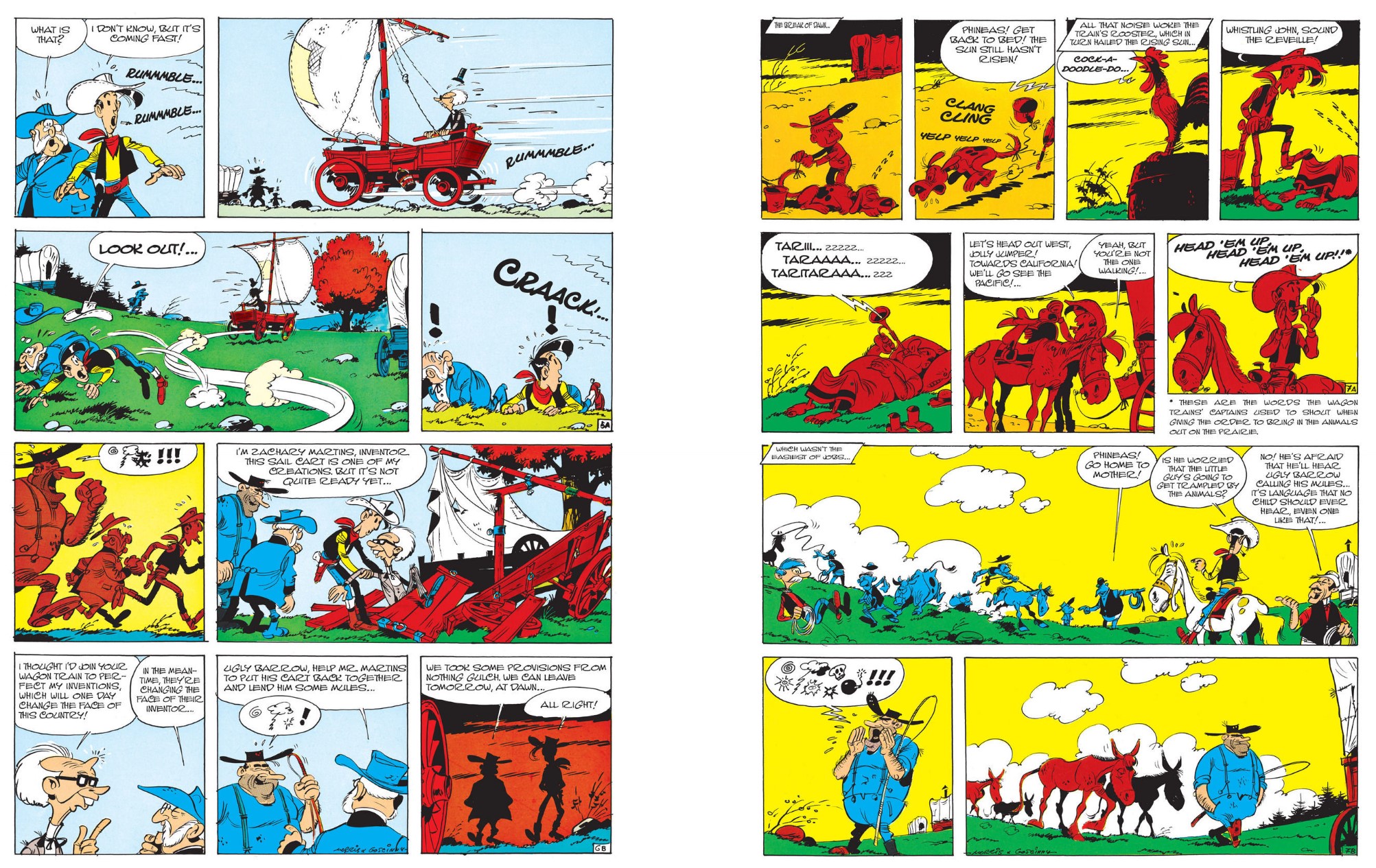
With close calls and near-death escapes mounting, Lucky splits his attention between blazing a trail and playing detective but the suspect pool is just too large. Anybody from the undertaker in his hearse to the inventor in his constantly evolving horseless converter-car (there’s more than a passing similarity to TV’s Whacky Races here!); the suspiciously French Barber/Surgeon, creatively foul-mouthed mule driver or even the no-nonsense School Marm could be the culprit. But then again, there are so many others who act out of the ordinary…
Nevertheless, the voyage proceeds and as the would-be homesteaders survive the temptations of bad towns and other dens of vice and iniquity, bad food, and inclement weather a sense of community builds. Sadly, that’s soon tested to the limit when word comes that Sioux Chief Rabid Dog is on the warpath…
Despite all these traditional trials and tribulations Luke persists, and before long the Promised Land is reached and a vile villain finally exposed.
Cleverly barbed, wickedly ironic and joyously packed with classic cowboy set-pieces, this splendidly slapstick spoof of a crucial strand of the genre is another grand old hoot superbly executed by master storytellers for any kids who might have missed the romantic allure of an all-pervasive Wild West that never was…
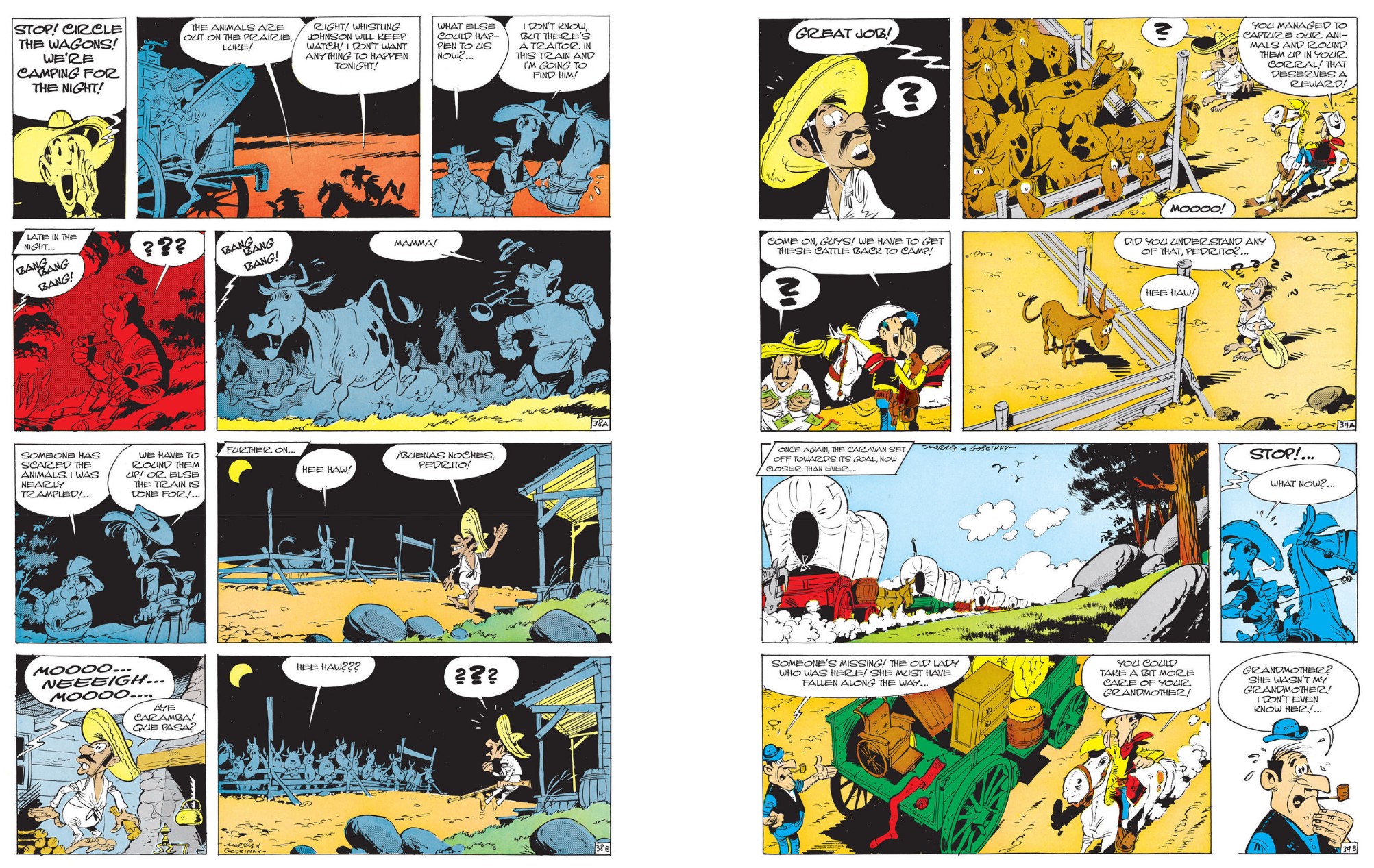
And in case you’re worried, even though the interior art still has our hero chawin’ on that ol’ nicotine stick, trust me, there’s very little chance of anyone craving a quick snout, but quite a strong probability that they’ll be addicted to Lucky Luke Albums…
© Dargaud Editeur Paris 1971 by Goscinny & Morris. © Lucky Comics. English translation © 2007 Cinebook.
Today in 1930: French comics pioneer Jean-Claude Forest – creator of Barbarella – was born.
Today in 1954 the premier issue of Tiger went on sale. After 1555 issues and seven decades, its top star remains Roy of the Rovers (see The Bumper Book of Roy of the Rovers ).



